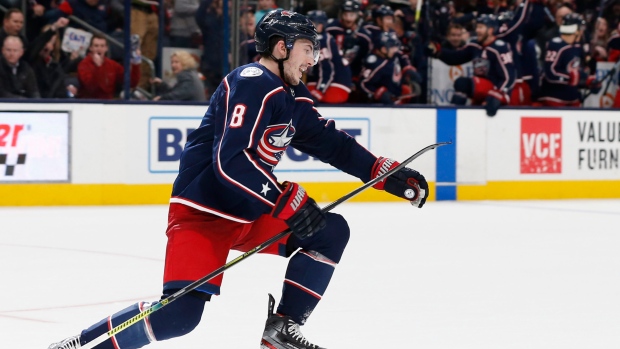Dec 3, 2020
Defencemen have changed the NHL’s offensive landscape
The modern blueliner is willing to shoot more frequently from much deeper in the offensive zone, which seems to be creating more scoring across the board, Travis Yost writes.
By Travis Yost

It has been a subtle shift over time, but scoring in the National Hockey League continues to climb. With no obvious, singular smoking-gun to explain the rising goal totals, hypothesizing continues unabated.
We already know that some observable shifts league-wide are helping the cause. The most obvious example? Teams are more aggressive shooting the puck, realizing that shot volume is a better relative driver of goal scoring than shot quality, though both are desirable components.
Consider what has happened in the NHL’s real-time scoring system (2007 to present), with shot rates and scoring rates juxtaposed:

Shot rates are up, and so too are shooting percentages on those attempts. Why is that important? Players haven’t started to trade out quantity for quality. The proportional increase in shots, to a reasonable degree, can explain why scoring around the league has started to tick up.
But it doesn’t serve to answer the question of how teams are creating these additional shooting opportunities, or why offensive shot creation has relatively superseded defensive shot suppression.
And this is merely one example. What happens when we incorporate other arguments into the mix? Power-play conversion rates are up despite fewer opportunities; the analytics community has long argued that the adoption of four-forward power-play units have helped this along.
What about changes to goaltender equipment size? The league has hung their hat on this for some time, and intuitively, less-bulky equipment means more of the net exposed for shooters.
We could spend weeks on this topic alone. But one part I want to circle back to is that increase in shot volume, particularly at 5-on-5.
With so much time and attention spent on managing defensive structure, it seems odd that teams around the league accept conceding more shots and, as we know, more goals. There is undoubtedly more skill in today’s game, but that’s true at all positions. So what’s going on?
I think a lot of it can be explained on the blueline. We know it’s the position that has experienced the most change, and by a considerable degree, over the past two decades. Long gone are the days of a 240-pound stay-at-home defenceman whose only goal is to slow opposing attackers.
Modern defencemen are expected to contribute on both ends of the ice, and there has been a heightened focus on sheer offensive skill.
Even that has changed over time. Compare the shooting profiles of Detroit’s Nicklas Lidstrom – one of the best offensive defencemen ever – in 2007-08 to Columbus’ Zach Werenski just last season.
Notice anything different? (Chart via HockeyViz)

At the time, Lidstrom was one of a kind – heck, even years later, one could argue that a similar offensive defenceman in Erik Karlsson was one of a kind. But great offensive defencemen are more readily available these days, and I could just as easily substitute in Dallas’ Miro Heiskanen, Nashville’s Roman Josi, Vegas’ Shea Theodore, and so on.
Not only are defencemen shooting more, but they are more aggressive in terms of where they are shooting from. Whereas even elite offensive defenders like Lidstrom would have stayed around the blueline during most shifts, offensive defencemen nowadays will aggressively pinch and look for shooting opportunities similar to their forward counterparts.
We see that in the aggregated data. If we look at the shot shares for defenders and forwards over time, we can draw a few important conclusions:

The three critical takeaways from the data set:
1. Defencemen are shooting more and scoring more, though their increase in shot volume is higher than their increase in goal volume;
2. Forwards are shooting about the same as they have been historically (and relatively less than their defencemen counterparts) and are also scoring more; and
3. Shooting percentages for defencemen have stayed flat; shooting percentages for forwards have increased.
The last part is the most important, and it ties back into the Werenski example above. The aggressiveness of the modern offensive defenceman – willing to shoot frequently, and willing to do so from much deeper in the offensive zone – seems to be creating more offence across the board.
Defensive units not only have to deal with much more capable puck carriers who can generate offence off the rush, they also have to deal with defenders pushing deeper into the offensive zone, gambling for additional scoring chances. (This, of course, can leave teams vulnerable to counterattacks when forwards fail to rotate on behalf of a pinching defender – another window for added scoring.)
More than anything else, it seems that this type of aggressive offensive strategy from blueliners creates chaos – a type of chaos that’s hard to deal with if you are chasing the puck in the defensive zone.
Defenders are not only creating scoring opportunities for themselves; they are also creating added scoring opportunities for their forwards in front. And so while defenders may be eating into the shot share of forwards, this evolution has made both units more productive scorers.
Add it to the list of possible explanations.
Data via Natural Stat Trick, Evolving Hockey, Hockey Viz, NHL.com

